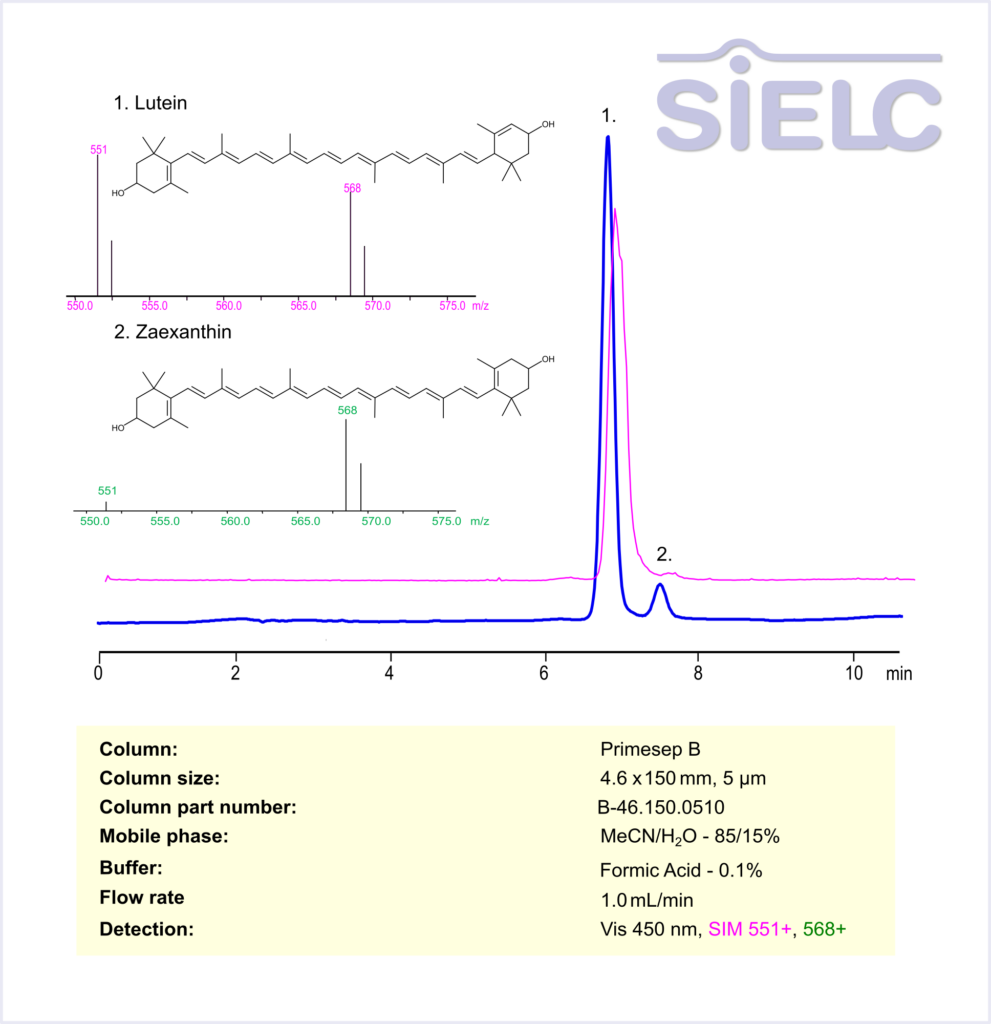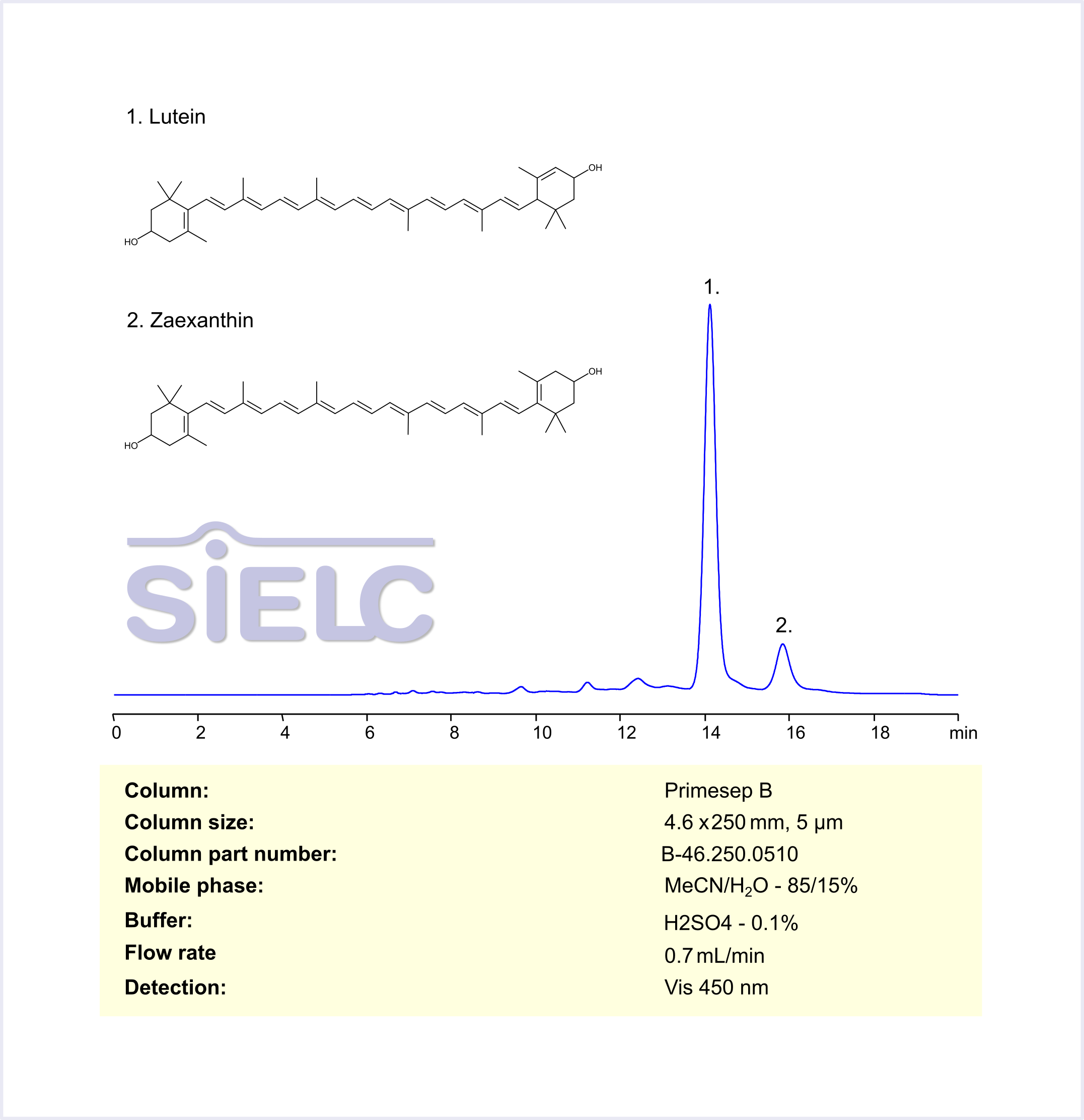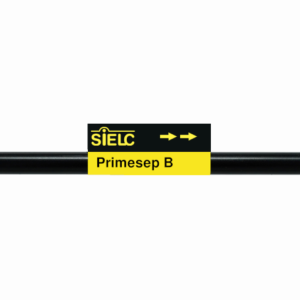| CAS Number | 127-40-2 |
|---|---|
| Molecular Formula | C40H56O2 |
| Molecular Weight | 568.886 |
| InChI Key | KBPHJBAIARWVSC-RGZFRNHPSA-N |
| LogP | 10.8 |
| Synonyms |
|
Applications:
HPLC MS Method for Analysis of Lutein and Zeaxanthin in Supplements on Primesep B Column
August 15, 2024
High Performance Liquid Chromatography (HPLC) MS Method for Analysis of Lutein, Zeaxanthin on Primesep B by SIELC Technologies
Separation type: Liquid Chromatography Mixed-mode SIELC Technologies

High Performance Liquid Chromatography (HPLC) Method for Analysis of Lutein, Zeaxanthin
Lutein is an oxygenated carotenoid, or xanthophyll, with the chemical formula C₄₀H₅₆O₂. It has a chain of conjugated double bonds and hydroxyl groups at each end, which give it strong antioxidant properties. Lutein’s ability to absorb blue light helps protect the eyes from oxidative stress. In plants, lutein stabilizes chlorophyll and protects cells from light-induced damage.
Zeaxanthin is also a xanthophyll carotenoid, sharing the same chemical formula as lutein, C₄₀H₅₆O₂, but with a different arrangement of double bonds. This structural variation allows zeaxanthin to be particularly effective in protecting the central macula of the retina. It filters harmful blue light and shields the eyes from oxidative damage, similar to lutein.
Lutein, Zeaxanthin can be retained, separated and analyzed using a Primesep B mixed-mode stationary phase column. The analysis employs an isocratic method with a simple mobile phase comprising water, acetonitrile (MeCN), and formic acid as a buffer. This method allows for detection using Vis 450 nm.
| Column | Primesep B, 4.6 x 150 mm, 5 µm, 100 A, dual ended |
| Mobile Phase | MeCN – 85% |
| Buffer | Formic Acid -0.1% |
| Flow Rate | 1.0 ml/min |
| Detection | Vis 450 nm, ESI MS SIM 551 +, 568+ |
| Class of Compounds | xanthophylls |
| Analyzing Compounds | Lutein, Zeaxanthin |
Application Column
Primesep B
Column Diameter: 4.6 mm
Column Length: 150 mm
Particle Size: 5 µm
Pore Size: 100 A
Column options: dual ended
Zeaxanthin
LC MS Detection

HPLC Method for Analysis of Lutein and Zeaxanthin in Supplements on Primesep B Column
August 13, 2024
High Performance Liquid Chromatography (HPLC) Method for Analysis of Lutein, Zeaxanthin on Primesep B by SIELC Technologies
Separation type: Liquid Chromatography Mixed-mode SIELC Technologies

High Performance Liquid Chromatography (HPLC) Method for Analysis of Lutein, Zeaxanthin
Lutein is an oxygenated carotenoid, or xanthophyll, with the chemical formula C₄₀H₅₆O₂. It has a chain of conjugated double bonds and hydroxyl groups at each end, which give it strong antioxidant properties. Lutein’s ability to absorb blue light helps protect the eyes from oxidative stress. In plants, lutein stabilizes chlorophyll and protects cells from light-induced damage.
Zeaxanthin is also a xanthophyll carotenoid, sharing the same chemical formula as lutein, C₄₀H₅₆O₂, but with a different arrangement of double bonds. This structural variation allows zeaxanthin to be particularly effective in protecting the central macula of the retina. It filters harmful blue light and shields the eyes from oxidative damage, similar to lutein.
Lutein, Zeaxanthin can be retained, separated and analyzed using a Primesep B mixed-mode stationary phase column. The analysis employs an isocratic method with a simple mobile phase comprising water, acetonitrile (MeCN), and sulfuric acid as a buffer. This method allows for detection using Vis 450 nm.
| Column | Primesep B, 4.6 x 250 mm, 5 µm, 100 A, dual ended |
| Mobile Phase | MeCN – 85% |
| Buffer | H2SO4 -0.1% |
| Flow Rate | 0.7 ml/min |
| Detection | Vis 450 nm |
| Class of Compounds | xanthophylls |
| Analyzing Compounds | Lutein, Zeaxanthin |
Application Column
Primesep B
Column Diameter: 4.6 mm
Column Length: 250 mm
Particle Size: 5 µm
Pore Size: 100 A
Column options: dual ended
Zeaxanthin

Separation of Lutein on Newcrom R1 HPLC column
May 16, 2018
Lutein is a yellow compound found in plants to modulate the amount of light hitting the chlorophyll molecule. In the human body, lutein is found in the eye, although its exact role is unknown. Lutein can be analyzed by this reverse phase (RP) HPLC method with simple conditions. The mobile phase contains acetonitrile (MeCN), water, and phosphoric acid. For Mass-Spec (MS) compatible applications the phosphoric acid needs to be replaced with formic acid. Smaller 3 µm particle columns are available for fast UPLC applications. This liquid chromatography method is scalable and can be used for isolation of impurities in preparative separation. It also suitable for pharmacokinetics.
.
Application Column
Newcrom R1
The Newcrom columns are a family of reverse-phase-based columns. Newcrom A, AH, B, and BH are all mixed-mode columns with either positive or negative ion-pairing groups attached to either short (25 Å) or long (100 Å) ligand chains. Newcrom R1 is a special reverse-phase column with low silanol activity.
Select options



